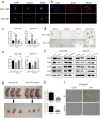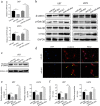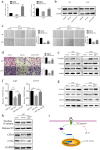miR-504 suppresses mesenchymal phenotype of glioblastoma by directly targeting the FZD7-mediated Wnt-β-catenin pathway
- PMID: 31419987
- PMCID: PMC6697940
- DOI: 10.1186/s13046-019-1370-1
miR-504 suppresses mesenchymal phenotype of glioblastoma by directly targeting the FZD7-mediated Wnt-β-catenin pathway
Abstract
Background: MicroRNAs (miRNAs) play crucial roles in tumor initiation and development. Previously, we indicated that miR-504 is downregulated and suppresses tumor proliferation in glioblastoma (GBM). However, the regulation and relevant mechanism of miR-504 in GBM mesenchymal (ME) transition remain unclear.
Methods: Transcriptome and clinical data were obtained from The Cancer Genome Atlas (TCGA) database. The potential functions of miR-504 were predicted using gene ontology analysis. GBM cell migration and invasion were examined using wound healing and Transwell assays. Epithelial-mesenchymal transition (EMT) progression in GBM cell lines was detected with immunofluorescence and western blotting. The stemness activity of glioma stem-like cells (GSCs) was assessed by sphere formation assay and tumor xenograft model. miR-504 binding to the FZD7 (frizzled class receptor 7) 3' untranslated region (3'UTR) was validated using dual luciferase reporter assay. TOP/FOP Flash assays were conducted to determine the effects of miR-504 on Wnt/β-catenin signaling.
Results: Analysis of TCGA transcriptomic data showed that low miR-504 expression correlated with ME subtype transition and poor survival in patients with GBM. Functional experiments showed that miR-504 overexpression suppressed malignant behaviors of GBM cells, such as migration, invasion, EMT, and stemness activity. Furthermore, miR-504 was a negative regulator of the Wnt-β-catenin pathway by directly repressing FZD7 expression, and FZD7 overexpression reversed the EMT inhibition caused by miR-504. Moreover, the low miR-504/FZD7 expression ratio was a ME subtype marker and could serve as a significant prognostic indicator and predict the clinical outcome of chemotherapy and radiotherapy for patients with GBM in TCGA dataset.
Conclusions: Our results suggest that miR-504 suppresses the aggressive biological processes associated with the ME phenotype of GBM and could be a potential candidate for therapeutic applications in these malignant brain tumors.
Keywords: EMT; FZD7; GBM; Mesenchymal phenotype; Wnt–β-catenin pathway; miR-504.
Conflict of interest statement
The authors declare that they have no competing interests.
Figures








Similar articles
-
MicroRNA-504 functions as a tumor suppressor in hepatocellular carcinoma through inhibiting Frizzled-7-mediated-Wnt/β-catenin signaling.Biomed Pharmacother. 2018 Nov;107:754-762. doi: 10.1016/j.biopha.2018.07.150. Epub 2018 Aug 21. Biomed Pharmacother. 2018. PMID: 30142536
-
miR-144-3p serves as a tumor suppressor by targeting FZD7 and predicts the prognosis of human glioblastoma.Eur Rev Med Pharmacol Sci. 2017 Sep;21(18):4079-4086. Eur Rev Med Pharmacol Sci. 2017. PMID: 29028093
-
miR-126-3p sensitizes glioblastoma cells to temozolomide by inactivating Wnt/β-catenin signaling via targeting SOX2.Life Sci. 2019 Jun 1;226:98-106. doi: 10.1016/j.lfs.2019.04.023. Epub 2019 Apr 10. Life Sci. 2019. PMID: 30980849
-
Regulatory role of miRNAs on Wnt/β-catenin signaling in tumorigenesis of glioblastoma.Indian J Cancer. 2023 Jul-Sep;60(3):295-302. doi: 10.4103/ijc.IJC_251_21. Indian J Cancer. 2023. PMID: 37787188 Review.
-
Wnt and PI3K/Akt/mTOR Survival Pathways as Therapeutic Targets in Glioblastoma.Int J Mol Sci. 2022 Jan 25;23(3):1353. doi: 10.3390/ijms23031353. Int J Mol Sci. 2022. PMID: 35163279 Free PMC article. Review.
Cited by
-
Elucidating the Anti-Tumorigenic Efficacy of Oltipraz, a Dithiolethione, in Glioblastoma.Cells. 2022 Sep 29;11(19):3057. doi: 10.3390/cells11193057. Cells. 2022. PMID: 36231019 Free PMC article.
-
MicroRNA-148a-3p suppresses epithelial-to-mesenchymal transition and stemness properties via Wnt1-mediated Wnt/β-catenin pathway in pancreatic cancer.J Cell Mol Med. 2020 Nov;24(22):13020-13035. doi: 10.1111/jcmm.15900. Epub 2020 Oct 7. J Cell Mol Med. 2020. PMID: 33026174 Free PMC article.
-
A complex of Wnt/planar cell polarity signaling components Vangl1 and Fzd7 drives glioblastoma multiforme malignant properties.Cancer Lett. 2023 Jul 28;567:216280. doi: 10.1016/j.canlet.2023.216280. Epub 2023 Jun 17. Cancer Lett. 2023. PMID: 37336284 Free PMC article.
-
Cancer chemoprevention through Frizzled receptors and EMT.Discov Oncol. 2021;12(1):32. doi: 10.1007/s12672-021-00429-2. Epub 2021 Sep 9. Discov Oncol. 2021. PMID: 34604862 Free PMC article. Review.
-
miR-637 Prevents Glioblastoma Progression by Interrupting ZEB2/WNT/β-catenin Cascades.Cell Mol Neurobiol. 2022 Oct;42(7):2321-2335. doi: 10.1007/s10571-021-01107-1. Epub 2021 May 28. Cell Mol Neurobiol. 2022. PMID: 34047878 Free PMC article.
References
MeSH terms
Substances
LinkOut - more resources
Full Text Sources
Medical
Miscellaneous

